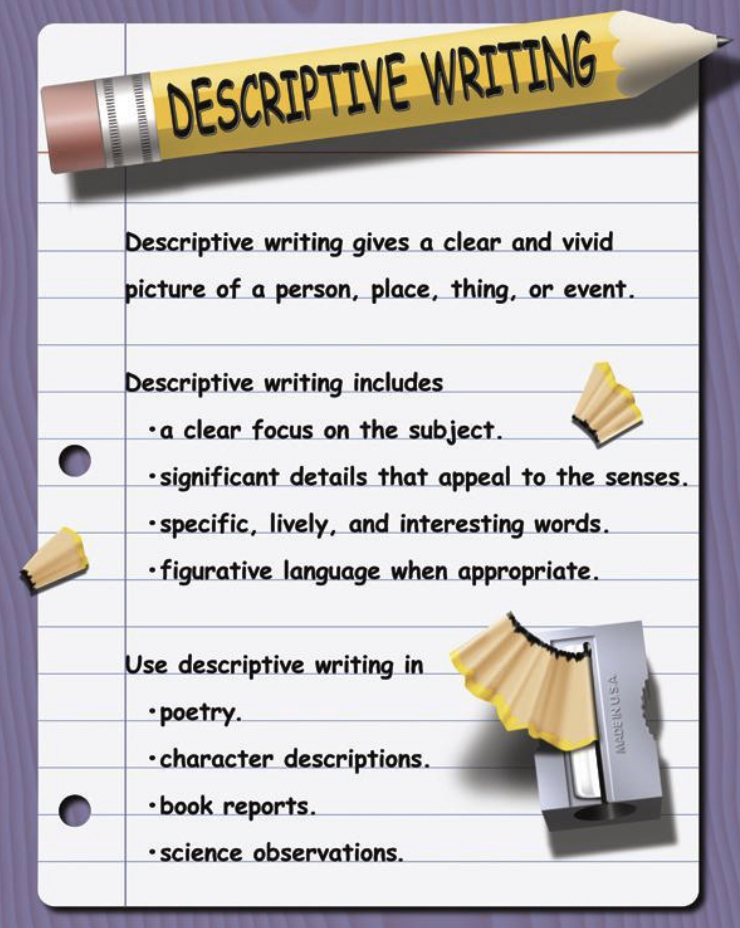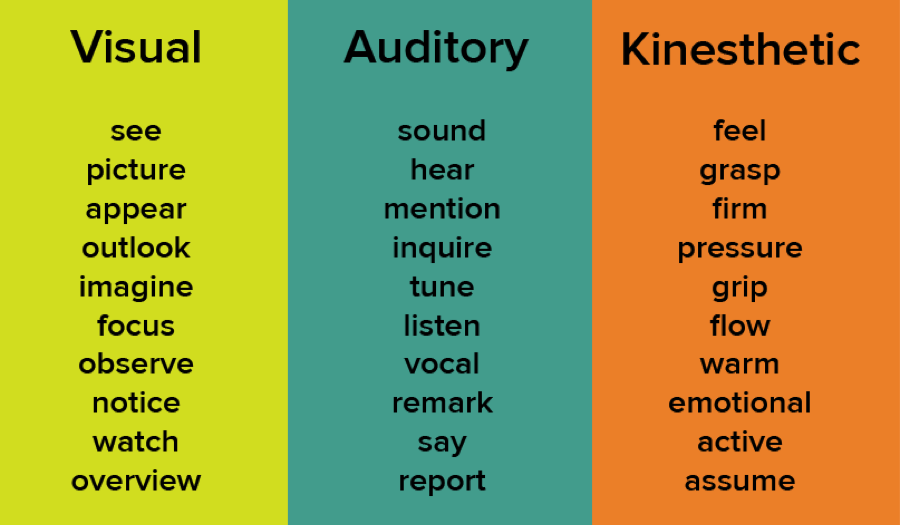DESCRIPTIVE WRITING
What is a descriptive essay?
A descriptive essay is an essay focused on describing something. That “something” can be anything, such as an event, a place, an experience, an object, or even a person. Descriptive essays aren’t the same as other kinds of essays, though you might find yourself using descriptive writing in other essay types to strengthen your argument.
Descriptive writing has a unique power and appeal, as it evokes sights, smells, sounds, textures, and tastes. Using description in your writing brings the world within your text to your reader.

When to use descriptive writing
Use descriptive writing almost anywhere your writing can benefit from immersive scene-setting. Most kinds of writing can benefit from a little bit of descriptive writing. Some, like fiction, poetry, and memoir, can benefit from a lot of it.
Instead of listing all the types of writing that can benefit from descriptive words, phrases, and sentences, here is a short list of the kinds of writing where this type of content is not appropriate:
- Technical writing
- Academic writing
- Professional emails and other correspondences
Descriptive writing is juicy. It evokes the reader’s senses. It’s the perfect tool for accurately communicating something that isn’t tangible, and that’s precisely why it’s not appropriate for the more formal, objective kinds of writing listed above.
Creating A Dominant Impression
The first step in using effective description is to focus on a dominant impression. A dominant impression creates a mood or atmosphere in your paper. This mood can be conveyed through effective descriptive writing. For example, pay attention to the mood in the following paragraph.
“My family ate dinner at Merrymead Diner every Friday night while I was a child. We huddled close in a large, red booth as we scanned the familiar menu. The aroma of gravy over creamy mashed potatoes lingered in the air. I snuggled close to my mom’s arm as she ordered our drinks. The waitress brought our thick milkshakes out on a tray and placed them in front of us on a paper doily. The jukebox in the back played songs that we all knew the words to, and we sang along until our food arrived, hot and enticing on the table. Outside I shivered in the cold air, but in the diner I was cozy, munching on crispy French fries and enjoying a hot, juicy cheeseburger.”

Sensory Details
Sensory description uses sight, sound, smell, touch, and taste to sketch an impression in writing. Consider a paragraph without a sensory description.
My sister and I walked along the boardwalk each afternoon of our vacation. We watched the ocean and listened to the waves. Usually, we stopped for a snack at one of the many stores that line the boardwalk. Afterward, we walked along the beach and let our feet get wet.
Now, consider this paragraph with all five sensory descriptors: sight, sound, smell, taste, and touch.
My sister and I walked along the boardwalk one afternoon on our vacation. The hot boards warmed our bare feet. We watched the foam-covered waves topple over each other and then slide back into the sea. The crashing water competed with the exuberant yells from the seagulls. We bought a perfectly oval fluff of pink cotton candy that dissolved sweetly in our mouths. Afterward, we walked along the edge of the water, letting the warm salty air blow our hair away from our necks as the cool water lapped over our toes.
What to Avoid When Using Sensory Detail
-
Too many adjectives—retain only the most powerful words in your writing, deleting any unnecessary words
-
Too many adverbs—verbs are stronger than adverbs. She strolled into the room more powerful than She walked casually into the room.
-
Clichéd figures of speech—overused language, such as green with envy, signals a lack of imagination. Use fresh, descriptive words that go against rote thinking.
Descriptive writing techniques
There are lots of different ways you can make your writing more descriptive. Here are a few of the most common descriptive writing techniques:
Metaphors
A metaphor is a descriptive technique that likens one thing to another. Take a look at these examples of common metaphors:
- My child is the light of my life.
- He’s the black sheep of our family.
- She’s a tornado that destroys everything in her path.
By stating that one object is another, you’re saying they share certain traits. You aren’t saying they’re indistinguishable or that they’re the same object; you’re expressing that the reader will encounter these specific traits in a very similar way in both objects.
Similes
A simile is like a metaphor. And yes, that was a simile.
Just like a metaphor, a simile describes something by comparing it to something else. The difference between the two is that a simile uses the word “like,” “so,” “then,” or “as” to make the comparison. For example:
- The building was as tall as Mt. Fuji.
- She drives faster than a NASCAR racer.
- They ate like a bunch of vultures.
Hyperbole
When you use an extreme statement to make a point, you’re using hyperbole. Here are a few quick examples:
- It was a million degrees out yesterday.
- I haven’t heard that name in a hundred years.
- He was the sweetest boyfriend ever.
Personification
It was a joyful bouquet. Each flower had a distinct, vibrant face and together, they were a happy choir of enthusiastic friends, ready to break into song at any moment.
We’re talking about flowers here and, as you know, flowers don’t have faces, voices, or friendships. But see how giving the flowers in this description human qualities like faces, voices, and interpersonal bonds gives you a clear image of the bouquet being described? It’s not just a collection of flowers; it’s a coherent group of fresh, healthy, colorful flowers.
Onomatopoeia
Pop!
Bang!
Cha-ching!
Roar!
Onomatopoeia is words for specific sounds. If you’ve ever watched the live Batman TV show from the 1960s, you’ve seen such onomatopoeia as “bam!” and “thwap!” flash across the screen during the fight scenes, creating a comic book-like feel. That’s what onomatopoeia does—it immerses you in the scene by giving it a “soundtrack.”

Good Examples of Descriptive Writing
Given below are a couple of good pieces of descriptive writing from authors who know their business.
‘But the door slid slowly open before Lupin could reach it. Standing in the doorway, illuminated by the shivering flames in Lupin’s hand, was a cloaked figure that towered to the ceiling. Its face was completely hidden beneath its hood. Harry’s eyes darted downwards, and what he saw made his stomach contract. There was a hand protruding from the cloak and it was glistening, greyish, slimy-looking, and scabbed, like something dead that had decayed in water…’
– Harry Potter and the Prisoner of Azkaban by J.K. Rowling
‘I don’t know what I’d expected but it was something different than I saw. She looked unexpectedly young. Or, I suppose said better, she looked unexpectedly “not old”. Her completely white hair had a yellowish cast that could almost have been mistaken for a pale blond, and it was loose around her shoulders. And long. Longer than mine. No doubt she normally wore it pulled up in a bun, and such a style would have given her a more predictable little old-lady look, but the way it was here now, parted on the sidelong, loose, and straight – she seemed ageless as an ancient sculpture. This sense was enhanced by her skin. Though it had the fragile creepiness of age, she had few wrinkles, especially across her forehead, which was smooth to a point of being almost waxy looking. She was of obvious northern Germanic heritage, with pale eyes and prominent features. Although she was not overweight, her bones were big and blunt, giving the impression of a tall, sturdy woman.’
– Twilight Children by Torey Hayden